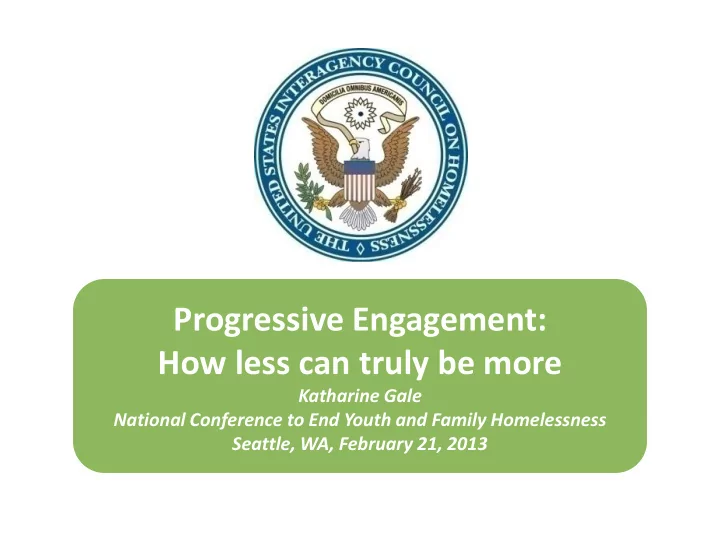

Progressive Engagement: How less can truly be more Katharine Gale National Conference to End Youth and Family Homelessness Seattle, WA, February 21, 2013
Overview • National objectives from HEARTH and Opening Doors • Common approaches to assigning resources • What do we mean by “Progressive Engagement”? • Essentials of a progressive engagement approach o Planning the program o Working with the households • Leading the culture shift http://www.usich.gov 2
From the HEARTH Preamble “…to establish a Federal goal of ensuring that individuals and families who become homeless return to permanent housing within 30 days.” - HEARTH Act purposes – Sec. 1002(b) http://www.usich.gov 3
Opening Doors Objective for Local Communities “Transform homeless services to crisis response systems that prevent homelessness and rapidly return people who experience homelessness to stable housing. ” http://www.usich.gov 4
How do we assign resources locally now? • Luck? • Persistence? • Assessment and Triage • Progressive Engagement http://www.usich.gov 5
Progressive Engagement A different kind of design: The lightest touch possible OR “You can always add more, but you can’t take it away.” http://www.usich.gov 6
What about Assessment? • Assessment is critical: need knowledge of the client’s relevant history, their current plans and desires • Understand housing barriers to be able to assist, not to refuse assistance • Developing a realistic approach to finding landlords and housing situations • Ability to link clients to supports in the community But: • Assessment up front may not be a good way to size the financial assistance or length of time services are offered Example: Let’s all go on a job hunt… http://www.usich.gov 7
Progressive Engagement Approach* PSH Independently Housed $$$$ RRH Point of RRH 1 1 RRH 1 Entry $$ $ $$$ http://www.usich.gov 8 *[Graphic from National Alliance to End Homelessness]
Progressive Engagement One resource or many? • Use different resources in tandem, based on their requirements and strengths, for different levels or phases of assistance Example: TANF ESG HOME TBRA $ $$ $$$ • Use one resource with regular reassessments and adjustments Example: ESG alone, local Child Welfare dollars http://www.usich.gov 9
Creating the Program What do you need to know? • The rules of the funding • The population and their housing barriers • Trends for lengths of stay and exits • Community partners o If we’re not going to provide the service, who can? Projecting the overall program size – knowing how to budget and staff (See Refinement) http://www.usich.gov 10
Working with the households • Frame the programs expectations and the help they’ll get to achieve them • Strengths-based approach • Specific plans to address concrete issues related to housing • Make clear you won’t abandon them but don’t over - invite more assistance than needed Set them up to succeed! http://www.usich.gov 11
Progressive Engagement What is essential to a progressive engagement approach to rehousing? • Flexible resources (money and staff) • Relationships with landlords • Links to other services in the community • Skill managing a flexible program • Partnership with clients to make a realistic plan • Messaging to clients, landlords, partners http://www.usich.gov 12
Core: A change in culture • Idea of doing the least for each household rather than the most • Believing people can make it without us • Staff get rewards from seeing people leave and helping more people • The pace is fast http://www.usich.gov 13
Leading the culture shift • Learn about successful approaches • Hear from clients about what they want • Take things step by step • Offer staff lots of support and training, but… o Also be open to staff changes • Use agency data to evaluate and adjust http://www.usich.gov 14
Measuring your impact From HEARTH • How many households are exiting to permanent housing? • How quickly? • Do they experience homelessness again? Also, consider cost per outcome http://www.usich.gov 15
Refining the Model Look at your outcomes and refine based on results: • Unacceptable loss rate or returns? • Maybe resize, assist longer, check in more, improve partnerships • Virtually everybody sticks? • Maybe do less • Some succeed and some don’t? • What factors can we look at to tell us what’s happening? (ex: family size, differences in income source, staff working with household, etc.) http://www.usich.gov 16
For More Information • USICH website (www.usich.gov) • Tools for Local Action • Program Profiles (coming soon) • National Alliance to End Homelessness (www.endhomelessness.org) • Homelessness Resource Exchange (www.hudhre.info) http://www.usich.gov 17
Stay Connected Katharine Gale, Policy Director Katharine.Gale@usich.gov Sign up for our newsletter at www.usich.gov Join us on and @usichgov http://www.usich.gov 18
U.S. Interagency Council on Homelessness www.usich.gov
Recommend
More recommend